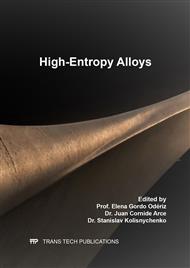[1]
Y.F. Kao et al., Microstructure and mechanical property of as-cast, -homogenized, and -deformed AlxCoCrFeNi (0≤x≤2) high-entropy alloys, J. of Alloys and Compounds 488 (2009) 57–64.
DOI: 10.1016/j.jallcom.2009.08.090
Google Scholar
[2]
E. Colombini, et al., SPS-assisted Synthesis of SICp reinforced high entropy alloys: reactivity of SIC and effects of pre-mechanical alloying and post-annealing treatment, Powder Metallurgy 61-1 (2018) 64-72.
DOI: 10.1080/00325899.2017.1393162
Google Scholar
[3]
M.G. Poletti et al., Development of a new high entropy alloy for wear resistance: FeCoCrNiW0.3 and FeCoCrNiW0.3 + 5 at.% of C, Materials & Design, 115 (2017) 247–254.
Google Scholar
[4]
O.N. Senkov, et al., Mechanical properties of Nb25Mo25Ta25W25 and V20Nb20Mo20Ta20W20 refractory high entropy alloys, Intermetallics 19 (2011) 698-706.
DOI: 10.1016/j.intermet.2011.01.004
Google Scholar
[5]
E.D. Tabachnikova et al., Mechanical properties of the CoCrFeNiMnVx high entropy alloys in temperature range 4.2–300 K, J. of Alloys and Compounds 698 (2017) 501-509.
DOI: 10.1016/j.jallcom.2016.12.154
Google Scholar
[6]
Y.F. Kao et al., Electrochemical passive properties of AlxCoCrFeNi (x = 0, 0.25, 0.50, 1.00) alloys in sulfuric acids. Corros. Sci. 2010, 52, 1026–1034.
DOI: 10.1016/j.corsci.2009.11.028
Google Scholar
[7]
B. Cantor, I. Chang, P. Knight, A. Vincent, Microstructural development in equiatomic multicomponent alloys, Mater. Sci. Eng. A 375-377 (2004) 213-218.
DOI: 10.1016/j.msea.2003.10.257
Google Scholar
[8]
J.W. Yeh, Alloy design strategies and future trends in high-entropy alloys, JOM 65 (2013) 1759-1771.
DOI: 10.1007/s11837-013-0761-6
Google Scholar
[9]
Y. Zhang, T.T. Zuo, Z. Tang, M.C. Gao, K.A. Dahmen, P.K. Liaw, et al., Microstructures and properties of high-entropy alloys, Prog. Mater. Sci. 61 (2014) 1-93.
DOI: 10.1016/j.pmatsci.2013.10.001
Google Scholar
[10]
F. Otto, A. Dlouhy, C. Somsen, H. Bei, G. Eggeler, E.P. George, The influences of temperature and microstructure on the tensile properties of a CoCrFeMnNi high-entropy alloy, Acta Mater. 61 (2013) 5743-5755.
DOI: 10.1016/j.actamat.2013.06.018
Google Scholar
[11]
Tsai M H, Yeh J.W, High Entropy Alloys: a Critical Review, Materials Research Letters, 2 (2014) 107-123.
Google Scholar
[12]
J.-W. Yeh et al., Nanostructured High-Entropy Alloys with Multiple Principal Elements: Novel Alloy Design Concepts and Outcomes, Advanced Engineering Materials, 6(5), (2004) 299–303.
DOI: 10.1002/adem.200300567
Google Scholar
[13]
E.Colombini et al., High entropy alloys obtained by field assisted powder metallurgy route: SPS and microwave heating, Materials Chemistry and Physics In Press, online 1 July (2017).
DOI: 10.1016/j.matchemphys.2017.06.065
Google Scholar
[14]
N. Nayan, et al., Hot deformation behaviour and microstructure control in AlCrCuNiFeCo high entropy alloy, Intermetallics 55 (2014) 145-153.
DOI: 10.1016/j.intermet.2014.07.019
Google Scholar
[15]
E.Colombini, Zirconium modified high entropy alloy for cryogenic application: a new prospective, Submitted.
Google Scholar
[16]
P. Veronesi, et al., Microwave processing of high entropy alloys: A powder metallurgy approach, Chemical Engineering and Processing 122 (2017) 397–403.
DOI: 10.1016/j.cep.2017.02.016
Google Scholar
[17]
W.C. Oliver and G.M. Pharr. An improved technique for determining hardness and elastic modulus using load and displacement sensing indentation experiments. J. of Materials Research. 6 (1992) 1564-1583.
DOI: 10.1557/jmr.1992.1564
Google Scholar
[18]
F.J. Humphreys and M.Hatherly, Recrystallization and related annealing phenomena, PERGAMON reprinted with corrections 1996. Elsevier Science Ltd. The Boulevard longford Lane, Kidlington, Oxford, OX5 IGB. UK.
Google Scholar



